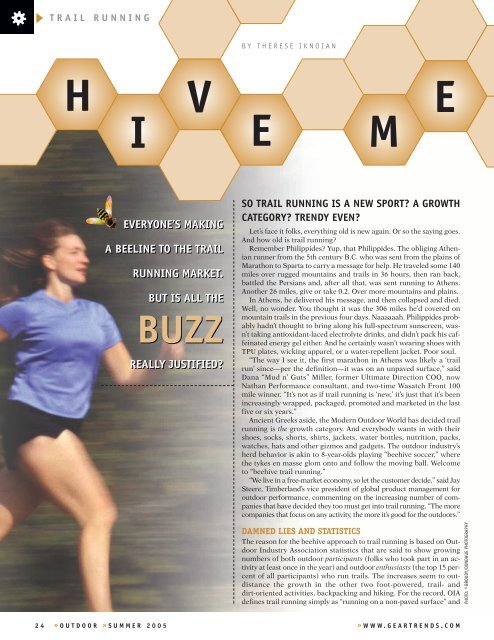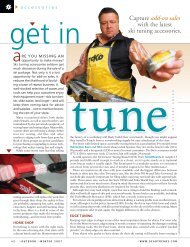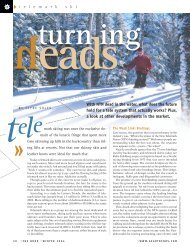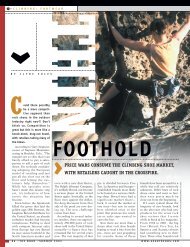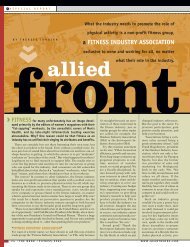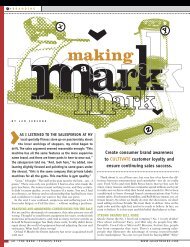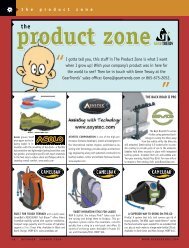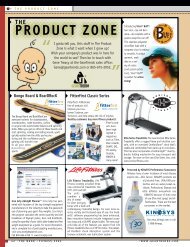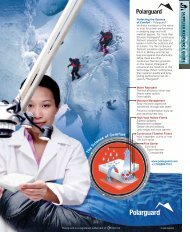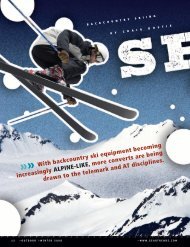Create successful ePaper yourself
Turn your PDF publications into a flip-book with our unique Google optimized e-Paper software.
24<br />
TRAIL RUNNING<br />
» OUTDOOR » SUMMER 2005<br />
EVERYONE’S MAKING<br />
A BEELINE TO THE TRAIL<br />
RUNNING MARKET.<br />
BUT IS ALL THE<br />
<strong>BUZZ</strong><br />
REALLY JUSTIFIED?<br />
BY THERESE IKNOIAN<br />
SO TRAIL RUNNING IS A NEW SPORT? A GROWTH<br />
CATEGORY? TRENDY EVEN?<br />
Let’s face it folks, everything old is new again. Or so the saying goes.<br />
And how old is trail running?<br />
Remember Philippides? Yup, that Philippides. The obliging Athenian<br />
runner from the 5th century B.C. who was sent from the plains of<br />
Marathon to Sparta to carry a message for help. He traveled some 140<br />
miles over rugged mountains and trails in 36 hours, then ran back,<br />
battled the Persians and, after all that, was sent running to Athens.<br />
Another 26 miles, give or take 0.2. Over more mountains and plains.<br />
In Athens, he delivered his message, and then collapsed and died.<br />
Well, no wonder. You thought it was the 306 miles he’d covered on<br />
mountain trails in the previous four days. Naaaaaah. Philippides probably<br />
hadn’t thought to bring along his full-spectrum sunscreen, wasn’t<br />
taking antioxidant-laced electrolyte drinks, and didn’t pack his caffeinated<br />
energy gel either. And he certainly wasn’t wearing shoes with<br />
TPU plates, wicking apparel, or a water-repellent jacket. Poor soul.<br />
“The way I see it, the first marathon in Athens was likely a ‘trail<br />
run’ since—per the definition—it was on an unpaved surface,” said<br />
Dana “Mud n’ Guts” Miller, former Ultimate Direction COO, now<br />
Nathan Performance consultant, and two-time Wasatch Front 100<br />
mile winner. “It’s not as if trail running is ‘new,’ it’s just that it’s been<br />
increasingly wrapped, packaged, promoted and marketed in the last<br />
five or six years.”<br />
Ancient Greeks aside, the Modern Outdoor World has decided trail<br />
running is the growth category. And everybody wants in with their<br />
shoes, socks, shorts, shirts, jackets, water bottles, nutrition, packs,<br />
watches, hats and other gizmos and gadgets. The outdoor industry’s<br />
herd behavior is akin to 8-year-olds playing “beehive soccer,” where<br />
the tykes en masse glom onto and follow the moving ball. Welcome<br />
to “beehive trail running.”<br />
“We live in a free-market economy, so let the customer decide,” said Jay<br />
Steere, Timberland’s vice president of global product management for<br />
outdoor performance, commenting on the increasing number of companies<br />
that have decided they too must get into trail running. “The more<br />
companies that focus on any activity, the more it’s good for the outdoors.”<br />
DAMNED LIES AND STATISTICS<br />
The reason for the beehive approach to trail running is based on Outdoor<br />
Industry Association statistics that are said to show growing<br />
PHOTOGRAPHY<br />
numbers of both outdoor participants (folks who took part in an activity<br />
at least once in the year) and outdoor enthusiasts (the top 15 percent<br />
of all participants) who run trails. The increases seem to outdistance<br />
the growth in the other two foot-powered, trail- and BROUDY/DONOHUE ©<br />
dirt-oriented activities, backpacking and hiking. For the record, OIA<br />
defines trail running simply as “running on a non-paved surface” and PHOTO:<br />
» WWW.GEARTRENDS.COM
not necessarily some gnarly mountain<br />
adventure. That means running<br />
on the dirt or bark path in the local city<br />
park counts as trail running.<br />
With that in mind, take a closer look at<br />
the data that seem to be attracting all the<br />
bees to the honey: OIA’s 2004 numbers,<br />
just out this summer, show 39.5 million<br />
participants and 6.2 million enthusiasts,<br />
for total growth since 1998 (when OIA<br />
started tracking the activity) of 20.3 percent<br />
and 47.4 percent, respectively. Pretty impressive.<br />
Compare that to backpacking<br />
participation and growth and shudder in<br />
your medial-posted shoes: 13.3 million<br />
participants (down 23.1 percent) and 1.8<br />
million enthusiasts (down 20 percent).<br />
Now, breathe, and compare the numbers<br />
to hiking: 75.3 million participants (down<br />
1.2 percent—so nearly flat) and 11.3 million<br />
enthusiasts (up 21.4 percent—yes, up).<br />
In case you missed it: The total number<br />
of hikers is still nearly double the total<br />
number of trail runners.<br />
TREND: 2004 vs. 1998<br />
Participant #’s ‘04 % Change<br />
Trail Running. . . 39.5 million . . . +20.3<br />
Backpacking . . . 13.3 million . . . -23.1<br />
Hiking . . . . . . . 75.3 million . . . -1.2<br />
Enthusiast #’s ‘04 % Change<br />
Trail Running. . . 6.2 million . . . . +47.4<br />
Backpacking . . . 1.8 million . . . . -20.0<br />
Hiking . . . . . . . 11.3 million . . . +21.4<br />
Source: OIA Outdoor Recreation Participation in the U.S.,<br />
7th Ed. (2005)<br />
But not so fast: Take a look at the most<br />
recent pattern, comparing the above 2004<br />
numbers with last year’s 2003 data. Numbers<br />
of trail running participants are now<br />
up a mere 4.1 percent, relatively comparable<br />
to hiking’s increase of 3.7 percent.<br />
Even the enthusiasts show somewhat similar<br />
numbers: Trail runners are up 7.7 percent,<br />
while hiking enthusiasts are up 6.2<br />
percent. (Backpackers? Well, we don’t want<br />
to depress you, but if you promise not to cry<br />
on our wicking technical running tee, we’ll<br />
» OUTDOOR » SUMMER 2005<br />
tell you the drop in<br />
backpacking enthusiasts<br />
was a precipitous<br />
46.7 percent, 2004 vs. 2002<br />
without a recovery or change in 2003—<br />
ouch—but the number of participants<br />
“only” dropped 3.7 percent over 2003.)<br />
TREND: 2004 vs. 2003<br />
Participant #’s ‘03 % Change<br />
Trail Running. . . 37.6 million . . . +4.1<br />
Hiking . . . . . . . 71.6 million . . . +3.7<br />
Enthusiast #’s ‘03 % Change<br />
Trail Running. . . 5.7 million . . . +7.7<br />
Hiking . . . . . . . 10.5 million . . . +6.2<br />
Source: OIA Outdoor Recreation Participation in the U.S.,<br />
7th Ed. (2005)<br />
Granted, trail running enthusiasts—only<br />
the most passionate—are out there more<br />
often than most people participating in<br />
other activities, each tallying 49 or more<br />
trail runs during 2004. The only other activity<br />
that registers such high numbers is<br />
cycling on paved roads at 52 or more times<br />
a year each. But, consider, if you are a cyclist<br />
or a trail runner, that could be your<br />
primary aerobic and fitness activity, meaning<br />
getting out once a week wouldn’t be<br />
unusual. It only seems natural that activities<br />
such as kayaking (three to seven times,<br />
depending on the type), telemark skiing<br />
(five times) and backpacking (seven times)<br />
rank lower in annual frequency, as does<br />
even hiking (15 times).<br />
So, growing you say? Well, hmm, we<br />
say, scratching our heads and furrowing<br />
our brows. Really? Not as booming as<br />
some claim. Still, with aging Baby<br />
Boomers seeking a softer workout, folks<br />
looking for an escape from the stresses of<br />
city life, and more interest in mindful and<br />
experiential pursuits in the outdoors, a<br />
huge wave of trail running may still sweep<br />
everybody off their asphalt streets. The<br />
outdoor industry is certainly hopeful: A<br />
2003 survey of outdoor retailers by Brooks<br />
Sports did show that about two-thirds reported<br />
they expected trail-related sales to<br />
grow over the next three years.<br />
“I feel running in general is growing<br />
again. Trail (running) will grow with it because<br />
people are beginning to realize that<br />
it is easier on your body and a lot more entertaining,”<br />
said Bryce Thatcher, long-time<br />
ultrarunner, Ultimate Direction founder<br />
and now Nathan Performance designer.<br />
“When I train on the roads, it’s Training.<br />
When I run on the trails, it’s Entertainment.”<br />
I’M IN!<br />
Trail running’s expected growth has caused<br />
optimistic manufacturers of outdoor gear<br />
and athletic products to swarm around<br />
the category—a category that is still relatively<br />
nascent in the grand scheme of all<br />
things outdoors.<br />
But let’s step back to see what got us to<br />
this swarm. Where did the official category<br />
of trail running come from? Following<br />
adidas’ 1994 Trail Response intro, one of<br />
the first outdoor companies to jump in was<br />
Montrail, then known as One Sport, which<br />
came out with two trail running models in<br />
1995, oh-so-imaginatively called TRS Low<br />
and TRS Mid, with TRS standing for Trail<br />
Running Sport, according to President Scott<br />
Tucker. He admits today that they really<br />
weren’t much more than light hiking shoes.<br />
Then came its first “real” trail running shoe,<br />
the Vitesse, in 1996, which Tucker also admitted<br />
would now be a light hiker. Nevertheless,<br />
it made a hit on the market because<br />
it offered foot protection and stability on<br />
the trail and was lighter weight.<br />
“We used EVA…. Whoa, what a concept,”<br />
he said, dripping with sarcasm. “The<br />
outdoor crowd said, ‘Oh cool.’ None of the<br />
outdoor companies were doing anything<br />
like this, and it had its niche.”<br />
Then the category started kicking, partly<br />
thanks to athletic company New Balance,<br />
which introduced the first of its 800<br />
series trail running shoes in 1997, but really<br />
launched the category with its 801 in<br />
1998. That took New Balance suddenly beyond<br />
its core of road running clients, as<br />
well as its image as a staid, older, conservative,<br />
gray-running-shoe company.<br />
WWW.GEARTRENDS.COM » 25
“Trail running was now considered<br />
a category,” Tucker said.<br />
Suddenly, the category turned into<br />
a scramble fest, with athletic companies<br />
such as Nike and adidas making<br />
plays since they already had<br />
more of the light technology, but didn’t<br />
necessarily have the other trail features.<br />
The outdoor companies woke up a tad<br />
slowly, realizing they too had to be there,<br />
with more athletic outdoor brands such<br />
as Salomon getting into the game more<br />
quickly. Others such as The North Face<br />
and Timberland tried to respond quickly,<br />
but they are the first to say their first attempts<br />
weren’t something to write home<br />
about. Now, The North Face has fully<br />
grabbed the category by the horns, while<br />
Timberland will try to return full-force for<br />
spring 2006 with its new Endurion shoes,<br />
having put the “Mountain Athletics” brand<br />
on the shelf.<br />
Since about 2001, other companies—<br />
even unexpected ones—have entered the<br />
trail running market, such as Pearl Izumi<br />
(relying on its cycling shoe heritage), Garmont<br />
and Vasque (leaning on their backpack<br />
boot backgrounds), Helly Hansen<br />
(banking on… umm… we aren’t sure), and<br />
La Sportiva and Five Ten (sticking to their<br />
climbing shoe outsole expertise). Other<br />
players include Columbia, Hi-Tec, Inov-<br />
8, Tecnica, Teva, French-brand Lafuma,<br />
Merrell, newcomer Asolo, and, of course,<br />
the athletic brands, such as Saucony and<br />
Asics. In apparel and hydration, aside from<br />
the above, we also have, among others,<br />
Patagonia, Hind, GoLite, Sugoi, Cloudveil,<br />
CamelBak, Ultimate Direction and<br />
Nathan.<br />
ENTER THE PLATYPUS<br />
When it came to designing trail running<br />
shoes, not all companies got it right at first.<br />
(Some say companies still aren’t getting it<br />
right.) Backpacking boot companies turned<br />
out products that were not much more than<br />
down-sized boots (too stiff, too heavy, etc.),<br />
while athletic shoe companies turned out<br />
products that were hardly more than road<br />
runners colored brown (too flimsy, not<br />
enough lateral support, etc.).<br />
“It was a lot of trial and error before the<br />
Velocity shoe,” said Rick Appelsies, vice<br />
president and general manager of Vasque.<br />
“Well, it was a lot of error, honestly. There<br />
were too many elements of a backpacking<br />
boot” in pre-2003 product that he jokingly<br />
called “great closeouts.”<br />
“We learned the hard way,” he added.<br />
Both athletic and boot companies also<br />
tried their hands at products called everything<br />
from “multi-sport” to “cross-training”<br />
to “outdoor conditioning” that were<br />
mostly neither animal nor vegetable. “If<br />
26<br />
TRAIL RUNNING<br />
» OUTDOOR » SUMMER 2005<br />
you design a multi-sport shoe,” Timberland’s<br />
Steere said, “you end up with a<br />
platypus—you don’t know what it is.”<br />
Montrail is still one company that others<br />
chase, despite being a blip on the company<br />
size continuum in comparison to the<br />
likes of Timberland, The North Face or<br />
Columbia. Vasque, even only with two<br />
years in the market, has leaped into a leadership<br />
position. In fact, a year ago, it<br />
swiped Montrail’s original biomechanics<br />
expert and designer, Jon Fewster.<br />
THE PLATYPUS GOES BY WAY OF<br />
THE GOONEY BIRD<br />
If you get down to brass tacks, trail running<br />
products are only now becoming truly refined,<br />
and they still have a ways to climb up<br />
the slope of technical advancement. Take a<br />
look at the background and growth from a<br />
small selection of companies. To see additional<br />
detail about past and present product<br />
for these companies and a few others, go to<br />
www.GearTrends.com/extras.<br />
Vasque’s 2003 shoe, the Velocity, didn’t<br />
find immediate success … until it won an<br />
outdoor magazine award. Appelsies said<br />
the award prompted phenomenal sellthrough<br />
and helped vault Vasque’s name<br />
high on the list of trail-running companies.<br />
(Granted, the Vasque Lite Speed shoe<br />
the following year pretty much bombed<br />
because the sock-like fit just wasn’t userfriendly,<br />
he added.) Now, Vasque has four<br />
models and will take the line to six with<br />
introductions at Outdoor Retailer Summer<br />
Market. Trail running is now the<br />
growth category for Vasque, a company<br />
previously known for big, brown backpack<br />
boots.<br />
The North Face’s President Steve Rendle<br />
said his company finally got it dialed in for<br />
2003 product, increasing sales for 2004<br />
by 60 percent. While the designs were<br />
STRAIGHT FROM THE RUNNERS’<br />
M O U T H S<br />
GearTrends ® asked a few dozen of our trail and ultra-running buddies<br />
some pointed questions about trail gear, purchases, product and marketing<br />
to get the straight scoop. In general, we found they are wise to<br />
posers who believe they can slap “trail” on a product and trick ‘em into<br />
thinking they should buy it. Here’s an excerpt of what they told us:<br />
» TRAIL SHOES. They want them because they recognize they offer more protection<br />
from ankle-rolling, more support, forefoot protection and traction, among<br />
other things. “Here’s the rub,” wrote one. “I don’t want a shoe built on a hiking<br />
last and called a trail running shoe or a running shoe with a different sole material<br />
or tread pattern called a trail running shoe. It has to be designed to the task,<br />
and I think only a couple of companies fit the bill.”<br />
» BUYING WHAT’S MARKED FOR TRAIL RUNNING. Said one runner, “Labeling something for<br />
trail running is simply a marketing gimmick. Trail runners will find what works and use it regardless<br />
of what it is for.” Others said they buy, “Whatever seems right,” while another said<br />
she goes with “whatever is comfortable.” Pointed out one, “I don’t really care if they label it<br />
trail running. Just don’t want them to make it more expensive because of that.” Added another,<br />
“If it is just something packaged differently, I won’t pay the premium.”<br />
» TRAIL-RUNNING SPECIFIC GEAR. “Mostly marketing,” asserted one. Another said he buys what<br />
his local store owner recommends (!). One said he pays more attention to stuff marked as trail gear,<br />
but ends up purchasing whatever seems to work best. Another commented, “If an item is marked<br />
as being suitable for trail running, then I am inclined to consider whether it would be of use to<br />
me. Basically, it’s the manufacturer positioning the item as being useful to me, and that fact suggests<br />
to me that I should give it some consideration.” But he’ll still have to be convinced.<br />
» A DREAM PRODUCT. Supports to prevent ankle sprains that fit well into a shoe and do not<br />
have seams or irritating inserts under the foot. A water measuring device that tells you how<br />
much you’ve drunk or how much is left, that you can also reset as you refill. More pockets to<br />
hold bottles and gear. A GPS system built-in to a shoe to track mileage. A stabilizer for backpacks<br />
to keep them from swinging and jostling. Shoes that drain better to eliminate sloshing<br />
for 20 minutes. Better toe box room so you don’t have to buy shoes a size or more larger.<br />
Mountain lion repellent. OK, that last one was a joke. Trail runners can be funny too.<br />
» WWW.GEARTRENDS.COM
honed, a couple of magazine awards also<br />
helped boost sales. The company’s line as<br />
of 2006 will have seven models, with styles<br />
for women and men. TNF also sponsors<br />
ultra-running ambassador and top racer<br />
Dean Karnazes, and it is the title sponsor<br />
of the first 100-mile trail race in the country,<br />
the Western States 100, and has plans<br />
to expand its athlete team multi-fold, Rendle<br />
said.<br />
A company most name as one to keep an<br />
eye on, Montrail, now lists 10 models—including<br />
the Hardrock which is nearing<br />
classic and cult acceptance having won<br />
various awards—and will have three new<br />
ones for spring 2006. Montrail also sponsors<br />
a bevy of trail-running and adventureracing<br />
athletes, including 2005 women’s<br />
Western States winner Annette Bednosky<br />
and other top-ranked athletes. The company<br />
supports about 100 trail events<br />
around the country, and began the Montrail<br />
Cup in 2002, a series of trail races “to<br />
objectively determine the best ultrarunner,”<br />
now co-sponsored by Sunsweet.<br />
La Sportiva started “messing around” in<br />
the trail running category about four years<br />
ago with the Exum Ridge shoe, according<br />
to Sales Manager Mark Day. The company<br />
decided it could look to its climbing<br />
heritage to create a shoe that had a stickier<br />
outsole and a better silhouette and control<br />
for ascending and descending. It too<br />
got a foot-up on its category acceptance<br />
by earning a magazine award. For spring<br />
2006, the company will have six new styles,<br />
jumping it to a total of 16 models. The trail<br />
running category is now its second-fastest<br />
growing category, and La Sportiva sponsors<br />
a team that Day calls a “cost-effective<br />
28<br />
TRAIL RUNNING<br />
GOTTA HAVE IT<br />
»<br />
So what are the hallmarks of a good trail<br />
running shoe that most would likely<br />
agree on?<br />
GOOD FIT » That’s a no-brainer.<br />
FOREFOOT FLEXIBILITY » Gotta be able to push off.<br />
UNDERFOOT PROTECTION » Stone bruises from<br />
trail debris and rocks are a pain.<br />
LIGHTWEIGHT » Who wants bricks on their dogs?<br />
TOEBOX ROOM » A pox on black toenails from uphills<br />
and downhills.<br />
TRACTION OR GRIP » How depends on the company<br />
and terrain.<br />
BREATHABILITY » Gets steamy on the trail.<br />
TRAIL STABILITY » So you don’t twist ankles or knees.<br />
OTHER OPTIONAL FEATURES depending on intended<br />
use, company credo or personal taste: cushioning,<br />
motion control, ability to drain water, quick drying,<br />
waterproofness, gaiter-compatibility.<br />
» OUTDOOR » SUMMER 2005<br />
test-and-destroy laboratory.”<br />
Although not what most would consider<br />
an outdoor brand, New Balance is also<br />
called out by many as a continuing leader<br />
in the category. The 801 shoe introduced in<br />
1998 helped move the company beyond its<br />
older demographic, and it now has more<br />
than 10 models, with the 10th generation<br />
for spring 2006, the 809, to be introduced<br />
at Outdoor Retailer Summer Market.<br />
Not hesitating a moment to bump heads<br />
with the Goliaths of footwear and trail running,<br />
Inov-8 moved its planned opening of<br />
a U.S. office from spring 2005 up to fall<br />
2004 and debuted at the 2005 Outdoor Retailer<br />
Winter Market trade show. From its<br />
headquarters (a 180-year-old historical<br />
church in the hills in the center of England)<br />
to its minimalist product design,<br />
Inov-8 dares to be different. Just as most<br />
companies are putting in more stability,<br />
more motion control, more support, more,<br />
more, more shoe, Inov-8 has maintained<br />
that it wants the foot to control the shoe<br />
and not vice versa. It’s taken out all the<br />
gels, air, springs and what-not and aimed<br />
to bring the foot lower to the ground, while<br />
maintaining lugs, traction and fast-draining<br />
breathable features. Said founder<br />
Wayne Edy, “We’ve tried to let the foot do<br />
what it does naturally. We allow your<br />
metatarsals to operate like piano keys.”<br />
Timberland, which will sprint back into<br />
the trail running category with its Endurion<br />
line for spring 2006, has been “sometimes<br />
successful and sometimes less than<br />
successful,” partly due to the challenge of<br />
gaining acceptance, said Steere. Its first<br />
foray in that direction was the Gorge MPO<br />
(standing for, yes, multi-purpose outdoor),<br />
in 1999 that he called the company’s “first<br />
sneaker.” That kicked off a few months later<br />
the Mountain Athletics brand, which by<br />
2002 was absorbed back into the Timberland<br />
brand. Now, with the Outdoor Performance<br />
category, it’s ready again: Look<br />
for its new line at Summer Market.<br />
WAIT, THERE’S MORE…<br />
Though most people will say that you only<br />
need a good pair of shoes to run trails, the<br />
trail running market extends far beyond<br />
footwear. Give Dana Miller his choice and<br />
he’d likely be the first to commit a fashion<br />
faux pas: Old polypro tops that “stunk like the<br />
dickens” and those “good ol’ shiny tights”<br />
that had wild Hawaiian prints. But getting<br />
enough fluids, wearing some fine technical<br />
threads and finding a great pair of shoes has<br />
sucked him in too since the days of cotton<br />
tees and no water on three-hour-plus runs.<br />
Still, the definition of trail apparel and<br />
accessories may have sidetracked some<br />
companies in search of sales. Just because<br />
something is marked “trail running” does-<br />
n’t mean trail runners will buy it (see<br />
“Straight from the Runners’ Mouths,” page<br />
26). For example, you can forget about<br />
skyrocketing sales of the canned oxygen<br />
that sits on the desk of Trail Runner magazine<br />
editor Michael Benge.<br />
Once runners get the right shoes, all they<br />
really need is water (for runs longer than<br />
about 90 minutes) and wicking apparel or<br />
protective outwear. The rest is frosting.<br />
When it comes to trail apparel, Patagonia<br />
is one company that has marked its spot<br />
as a key supplier. It partnered early on<br />
with Montrail for a “strong grassroots<br />
partnership,” said Rob BonDurant, director<br />
of brand marketing. “We started<br />
developing for the ultra market in 2001,”<br />
he added. “Trail runners are the happy accident.”<br />
He admitted you can of course<br />
wear the good stuff that wicks, dries quickly,<br />
is durable and doesn’t chafe for anything,<br />
including hanging out over a burrito<br />
and beer for which you carried the<br />
money in one of the built-in pockets. For<br />
spring 2006, the company is revamping<br />
and restyling several key pieces.<br />
The third mandatory item, therefore, in<br />
the mandated triad is hydration. CamelBak<br />
and, to some degree, Ultimate Direction still<br />
seem to nearly own the trail running market.<br />
While at a trailhead or race, take a look<br />
around, and those brands are pretty much<br />
all you see, including hundreds of UD’s<br />
FastDraw holsters to hand-carry bottles<br />
(developed some 17 years ago).<br />
But a not-so-newcomer getting a<br />
makeover may make some inroads. Nathan<br />
Performance (now dubbed Nathan Human<br />
Propulsion Laboratories) is a long-time supplier<br />
to marathon runners and other roadrunners.<br />
A year ago it hired UD founder/designer<br />
Bryce Thatcher to spiff up the line,<br />
and new products are now on the market,<br />
including bottle carriers and hand-straps,<br />
with more coming, including backpackstyle<br />
hydration systems and women’s-specific<br />
designs. Thatcher told GearTrends ®<br />
that the goal is to cater to the elite and the<br />
enthusiast, with key concepts for Nathan<br />
being “Fluids, Freedom and Weight.”<br />
WHAT TRAIL? WHERE?<br />
Once consumers buy their trail-related shoes<br />
or gear, what do they really do with it?<br />
Appelsies, Tucker, Steere and others acknowledge<br />
that only about 10 percent of<br />
trail running shoes are ever used for actual<br />
running on dirt. Many are, in fact, the<br />
college-campus, around-town and coffeehouse<br />
sneakers of today, with another large<br />
portion taking the place of chunky, stiff<br />
backpacking and hiking boots of yore.<br />
“Walking and light hiking are what the<br />
overwhelming number of participants on<br />
trails are doing,” said. Dave Baker of Ari-<br />
» WWW.GEARTRENDS.COM
zona’s Summit Hut. “We have folks buying<br />
trail running shoes to walk in and for<br />
lifestyle because they look durable.”<br />
Timberland’s Steere said most people<br />
today under about the age of 50 have grown<br />
up in sneakers; they are accepted footwear<br />
on the street, in restaurants and at work,<br />
and today’s trail runners look a lot nicer<br />
than the glaring white athletic shoes we all<br />
used to wear. Plus, they have cachet.<br />
“If they are good enough for Dean Karnazes<br />
running 300 miles, then they’re good<br />
enough for me barbequing in my backyard,”<br />
said Joe Flannery, TNF vice president<br />
of marketing. “Whether it’s barbequing,<br />
hanging out or going for a five-mile<br />
hike, they’re just comfy.”<br />
The lines between lifestyle, outdoor and<br />
trail running footwear are so blurred that<br />
Lowa, in an ongoing Internet survey of its<br />
customers, found that more than a third<br />
are interested in a “trail running/outdoor<br />
fitness” shoe, but only one in five said they<br />
trail run. Nearly three-quarters said they<br />
hike on trails, and a few clicks less reported<br />
they walk. The Lowa customers confirmed<br />
that comfort is king, with nearly two-thirds<br />
voting that as the No. 1 desire in footwear.<br />
“Our customers are running errands<br />
more than they are running trails,” said<br />
Jason Erfling, buyer for the Alpine Shop in<br />
St. Louis. “Customers are opting for trail<br />
running shoes because of the comfort and<br />
cushioning, and they want an outdoor<br />
image rather than a running shoe image.”<br />
So huge is the hanging-out aspect that<br />
even Mark Day of La Sportiva said, albeit<br />
with some sarcasm, that it’s “unfortunate”<br />
its customers do indeed use its shoes for<br />
pursuits on dirt.<br />
“I need what I call ‘the Starbucks shoe,’”<br />
he said. “I want to see my shoes on soccer<br />
moms’ feet who have to walk around puddles…<br />
What color is their money?”<br />
The trail runner, it seems, is becoming<br />
the all-around casual and outdoor shoe.<br />
Partly because of culture, but also partly<br />
because of advancements in design and<br />
technology, it now goes from hanging out<br />
to hiking, from boulevard to backpacking.<br />
And that is what is likely prompting<br />
the sales spurt and beehive mentality.<br />
“The technology has evolved now to<br />
where you can get what you need in a<br />
lighter-weight package,” said Tucker of<br />
Montrail. “You can get great traction. You<br />
can get great protection. You can get great<br />
stability and so forth. Like you used to<br />
have to go to a hiking boot to get. And—<br />
guess what?—it costs less.”<br />
» To see additional story quotes and participation<br />
stats, as well as more company detail, product information<br />
and prices, go to www.GearTrends.com/extras.<br />
» OUTDOOR » SUMMER 2005<br />
Photo courtesy of NASA<br />
“The Toughest Clothes<br />
on the Planet.”<br />
ENGINEERED FOR ADVENTURE<br />
Come see us at Outdoor Retailer at Booth #3396.<br />
1-800-437-3794 · www.railriders.com<br />
®<br />
FREE SNEWS? FOR REAL?<br />
Yep…really. We’re giving away free one-year subscriptions<br />
to support retail training. If you’d like your store’s<br />
sales team to be receiving their own SNEWS ® subscription<br />
(for FREE*), packed with industry insight, selling<br />
tips, merchandising advice and how-to-sell guides, AND<br />
a free one-year subscription to GearTrends ® magazine,<br />
then send an email to: freesnews@snewsnet.com.<br />
*The fine print: Only sales staff engaged in selling products directly to customers and employed by an outdoor retail store are eligible to receive this offer.<br />
get informed & get ahead with SNEWS ®<br />
WWW.GEARTRENDS.COM » 29


